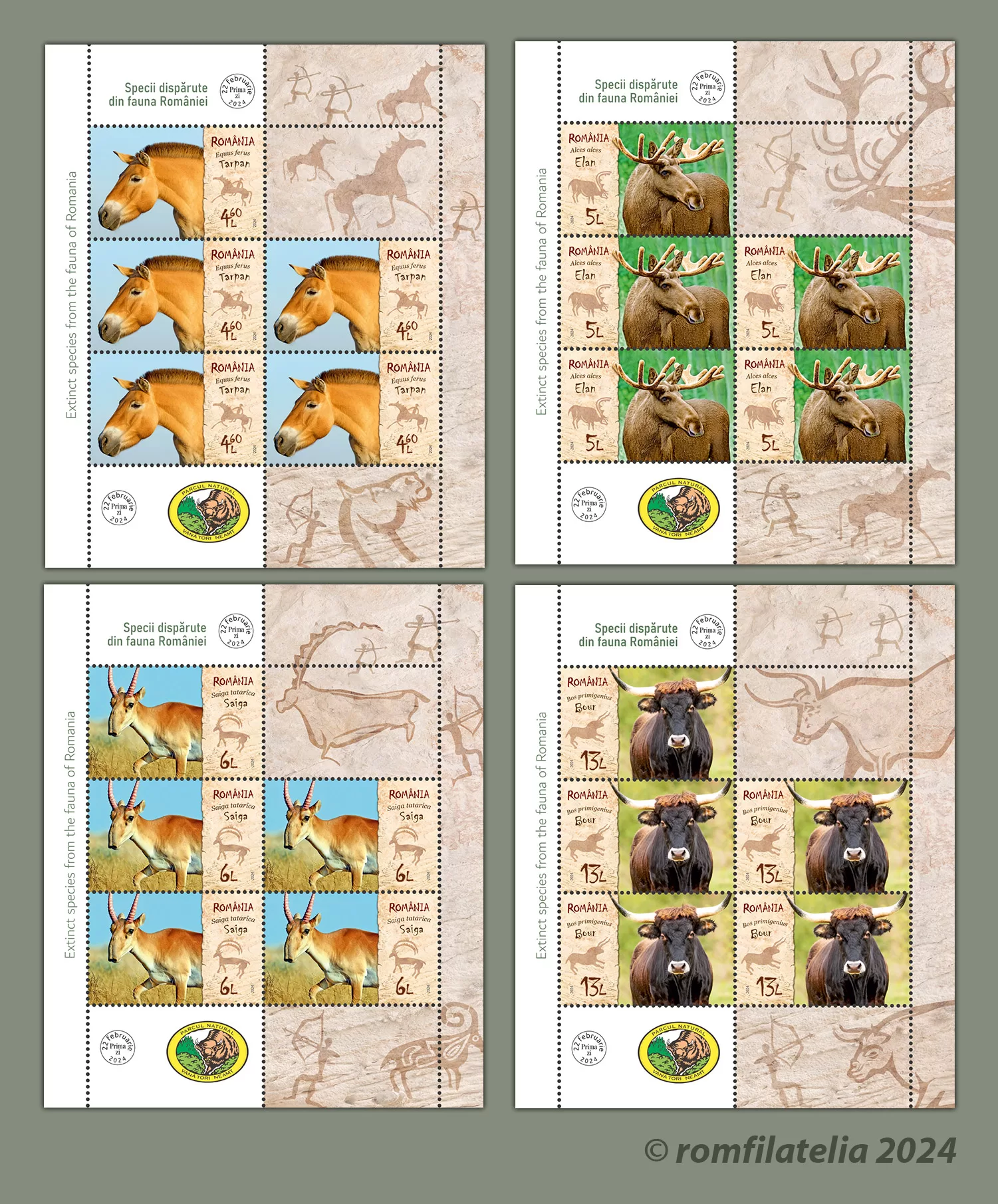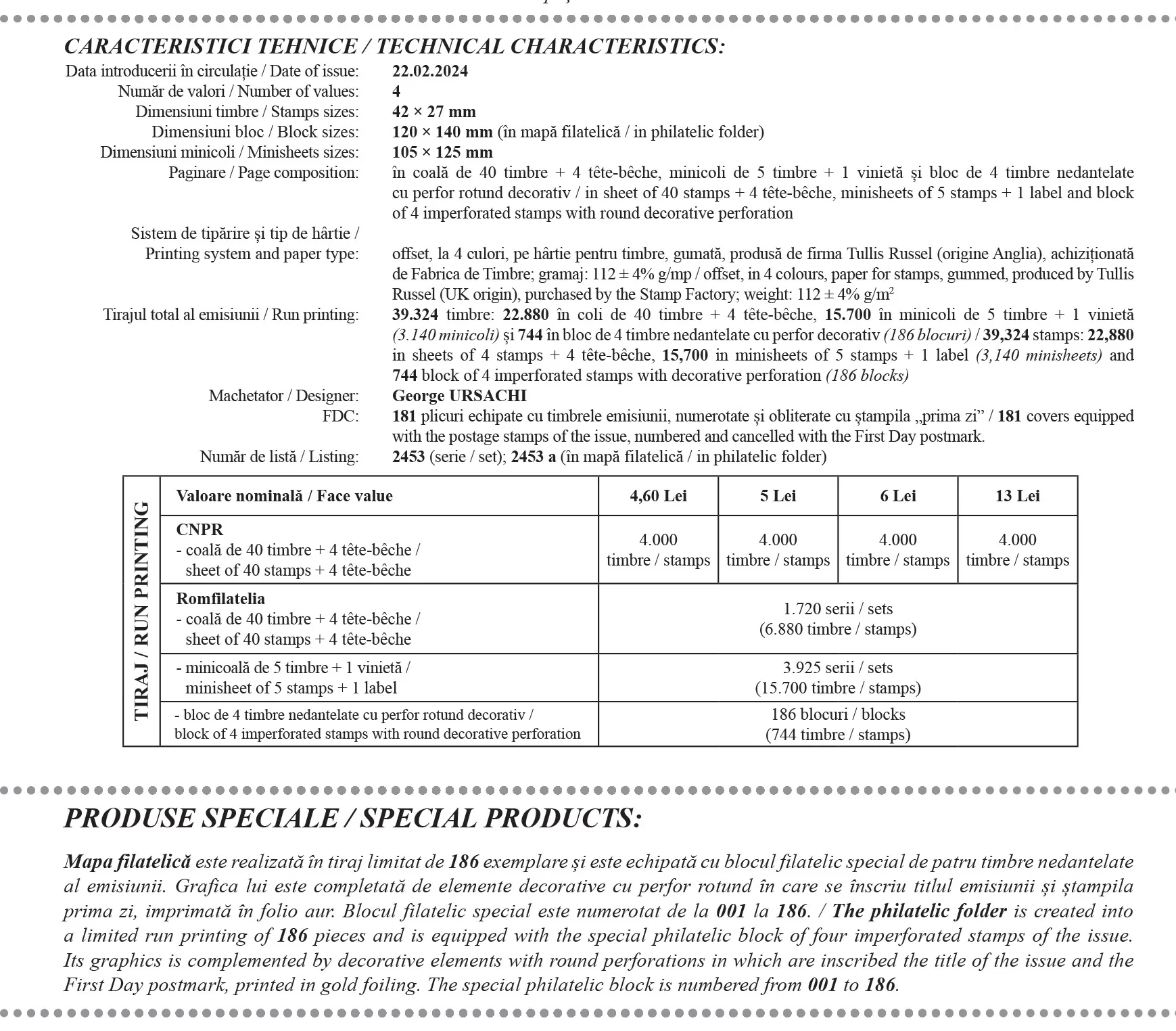 Romfilatelia provides the collectors and the general public, a new issue with the Fauna theme, under the generic title “Extinct species from the fauna of Romania”, composed of four stamps, a First Day Cover and a special product in a limited edition. The issue will be introduced into circulation on Thursday, February 22nd , 2024.
Romfilatelia provides the collectors and the general public, a new issue with the Fauna theme, under the generic title “Extinct species from the fauna of Romania”, composed of four stamps, a First Day Cover and a special product in a limited edition. The issue will be introduced into circulation on Thursday, February 22nd , 2024.
Romfilatelia brings back to the public’s attention five of the species of large herbivores, until recently part of the existing fauna on the territory of present-day Romania.
The Vânători-Neamț Nature Park is the only protected area that has assumed, through the management plan, “the reintroduction of large wild herbivores that have disappeared from Romania’s fauna”.
On the stamp with the face value of Lei 4.60 is illustrated the Tarpan – wild horse (Equus ferus). The wild horses were present in the frozen steppes stretching from the Northern European Plain to Siberia. They also existed on the territory of present-day Romania, the archaeological evidence covering almost the entire country.
Moose / Elk (Alces alces) is depicted on the stamp with the face value of Lei 5.
The historical spread area of the species extended from the Pyrenees to the Russian Plain, if we refer to the European space. In fact, as proof of their expansion to the south, moose are represented alongside bison or aurochs in the famous prehistoric drawings from the caves of Altamira, Lascaux or Chauvet.
Beyond the Carpathians, in Moldavia, the moose, called “plotun” by our ancestors, was also noted in the chronicles of the time.
On the stamp with the face value of Lei 6 is illustrated the species Saiga (Saiga tatarica), spread from Western Europe to the extreme northwest of the American continent, being adapted to a cold and dry climate. The presence of the saiga on the territory of Romania is certified in the chronicles of the 16th century. The Moldovan peasants have known it for a long time under the name “wild sheep”.
Aurochs (Bos primigenius) is depicted on the stamp with the face value of Lei 13.
Except for the north of the continent, the aurochs was present in Europe, historically speaking, over large areas. The presence of the aurochs was certain in the 12th century in the Pannonian area, the Baltic territories, where the aurochs lived until the 14th-15th centuries, so that in Poland, where it benefited from a special protection status, it was conserved until the beginning of the 17th century.
There is an assumption that the aurochs disappeared from Moldavia sometime in the 15th century, remaining in a state of freedom longer than in other parts of Europe. As proof of the presence was the using of the seals on which were clear representations of the aurochs, with long horns, in the shape of a lyre.
Khulan / Mongolian Wild Ass (Equus hemionus) is illustrated on the First Day Cover, his fossils being found in large areas: around the Mediterranean, at the North Sea, in the Caucasus or on the banks of the Volga. Human interventions caused the species to disappear relatively quickly from the European landscape, small numbers remaining in southern Europe and the Caucasus, until around 500 BC.
The Mongolian wild ass has been reintroduced in Ukraine in the Askania-Nova Biosphere Reserve in the Kherson Region, since the 1950s and in the Tarutino Steppe, in Bugeac, since 2020.
Romfilatelia thanks Mr. Sebastian Cătănoiu, Director, PhD., Vânători Neamț Nature Park Administration, for the documentary support granted to the development of this issue of postage stamps.



